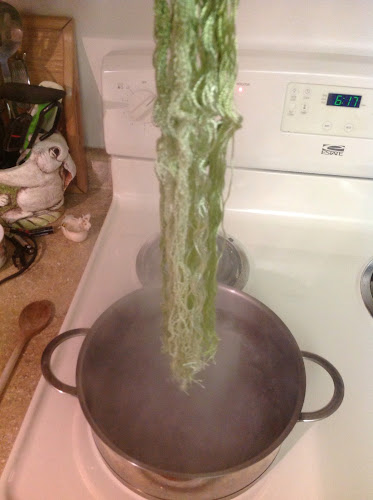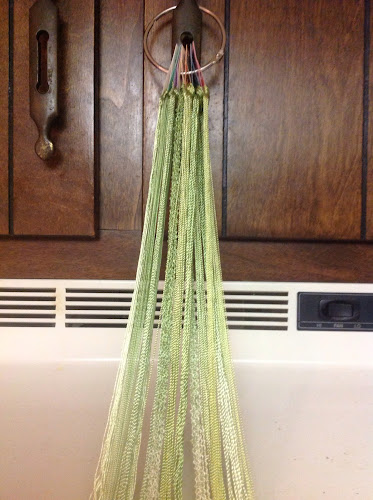One of the characteristics of Brazilian embroidery is the use of rayon embroidery threads in different weights and textures. Rayon gives the embroidery a fantastic sheen and also makes those complicated knots and bullions a lot easier to make.
Rayon is derived from plant material, but then is highly processed to make threads and yarns. Its complicated manufacturing process was first developed in the 1880s in France. From what I've read, Brazilian women first started home-dying the threads to use in Brazilian embroidery. You can still find people dying and selling small batches of rayon threads, but EdMar has the corner on commercially produced threads specifically for Brazilian embroidery.
EdMar produces seven different threads in over 240 different color combinations, including many unusual varigated combinations. The threads vary in both weight and texture. They are non-divisible and have an Z twist rather than the S twist of most floss, such as DMC cotton floss. This means that when you use Brazilian threads, you need to stitch somewhat backwards to get the same look. For example, threads are always wrapped clockwise around the needle and the thread is thrown to the top rather than the bottom when doing stem stitch. Mary Corbet provides a good example of the difference between S and Z twist stitching on her blog Needle 'N Thread.
Glory is the finest thread. It is about the same thickness as a single strand of DMC cotton floss.
Iris is the most commonly used thread in Brazilian embroidery. It is the same thickness as 2-3 strands of DMC.
Lola, about the thickness of 4 strands of DMC, is used for making bigger knots and flowers. It is a 3-ply thread, although the threads are not divisible.
Nova is the thickest of the threads, equaling 6 stands of DMC floss.
Except for their weight, each of these threads works up similarly. They have great sheen and are easy to knot. If you wrap them the wrong way on your needle though, you may notice some unravelling, especially with the thicker threads. These are tough, heavy duty threads. They have to be because you tend to have to tug pretty hard on some of the heavily wrapped knots.
EdMar also produces three threads that differ in texture from those above.
Frost is similar in weight to Lola, but it is more tightly wrapped. This gives your stitches a more defined look--almost frosty!
Cire is the same weight as Frost and Lola, but less tightly wrapped. This thread shreds easily, but looks glossy and has a very silky sheen when it is used for satin stitch. I don't use it often, but I love how it looks when I do.
Finally, Boucle is crinkly. It is usually used for flowers and other objects that are wrapped and tacked rather than with stitches that pass through the fabric. It is so much fun to use!
EdMar threads come in skeins that must be prepped before using.
1. Find the knot under the tag and clip through just the knotted length of thread. Unravel the skein, but don't take it out of the paper tag.
2. Use a bent wire, bent cardboard or plastic or even a small crochet hook to pull one length of thread through the paper tab.
3. Hang the threads on a round clip or piece of wire.
4. Steam the threads over a boiling pot of water or with a clothes steamer or iron (don't actually iron the threads) for 2-3 minutes. I usually steam over a pot of water because I can do multiple threads at once. Do not get the threads wet! I bounce them a little and comb them with my fingers, sometimes holding the threads parallel to the stove top to be sure the top of the threads are steamed as well. The kinks straighten out in just a few minutes.
5. Pack the threads for use, either in individual plastic bags or specialized thread holders. I like packing my threads in bags because then I can put the threads for an entire project on a ring to keep them organized.
Next time I revisit this short series on Brazilian embroidery I will show a few different stitches made up in each of the threads so you can better see the differences between them.
Here is the whole range of EdMar colors hanging on the wall at The Stitching Shop in Denver, CO.








Nice tip, Margo - I love the photo of the squiggly thread over the steaming pot! Looks like you're getting ready to cook dinner!
ReplyDeleteIt does look like pasta! But don't they look fantastic after they have been steamed? And they feel so silky then. It is a hassle to steam the threads sometimes, but so satisfying!
ReplyDelete